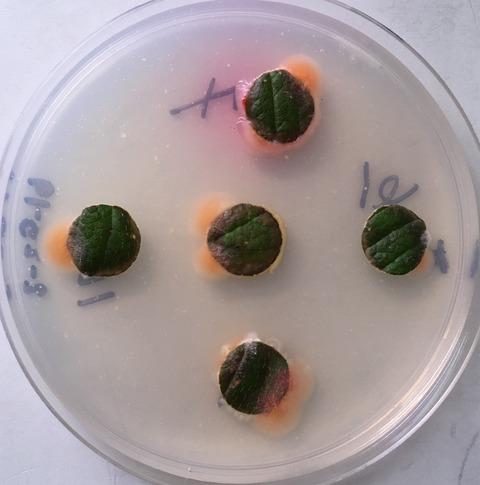当前位置:
X-MOL 学术
›
Plant Pathol.
›
论文详情
Our official English website, www.x-mol.net, welcomes your
feedback! (Note: you will need to create a separate account there.)
The potential for Fusarium oxysporum f. sp. fragariae, cause of fusarium wilt of strawberry, to colonize organic matter in soil and persist through anaerobic soil disinfestation
Plant Pathology ( IF 2.3 ) Pub Date : 2020-07-02 , DOI: 10.1111/ppa.13225 Peter M. Henry 1 , Megan Haugland 2 , Lia Lopez 2 , Mariel Munji 2 , Dean C. Watson 2 , Thomas R. Gordon 2
Plant Pathology ( IF 2.3 ) Pub Date : 2020-07-02 , DOI: 10.1111/ppa.13225 Peter M. Henry 1 , Megan Haugland 2 , Lia Lopez 2 , Mariel Munji 2 , Dean C. Watson 2 , Thomas R. Gordon 2
Affiliation

|
Fusarium wilt of strawberry, caused by Fusarium oxysporum f. sp. fragariae, is a disease of primary concern for strawberry production in many countries. Crop rotation and anaerobic soil disinfestation (ASD) have gained recent interest for their potential to contribute to management of this disease. Both techniques involve incorporation of organic matter into soil, which may be utilized by strains of Fusarium that are competitive saprophytes. We show that F. oxysporum f. sp. fragariae can colonize strawberry, lettuce, raspberry, and broccoli leaf tissues, which are sources of organic matter generated during crop rotation. This pathogen increased in soil population density during ASD treatments that did not become anaerobic, possibly as a result of growth on the organic amendment. However, significant population decreases were observed after ASD treatment when at least 100,000 cumulative reduced mV hours occurred in a 14‐day experiment. Post‐ASD abundance of F. oxysporum f. sp. fragariae in soil was negatively correlated with cumulative reduced mV hours. The only treatment that consistently caused disinfestation was exposed to a maximum temperature of 22 °C, which indicates there is potential for developing effective ASD treatments in the cool climates where strawberries are grown. Awareness that F. oxysporum f. sp. fragariae can act as a competitive soil saprophyte should be further investigated for its potential to alter disease outcomes where organic amendments are applied.
中文翻译:

尖孢镰刀菌的潜力f。sp。草莓镰刀菌枯萎病的病菌,草莓在土壤中定殖并通过厌氧性土壤杀灭而持续存在
草莓枯萎病(Fusarium oxysporum f)引起的草莓枯萎病。sp。fragariae,在许多国家的草莓生产主要关注的疾病。轮作和厌氧土壤杀虫(ASD)因其有助于控制该病的潜力而获得了近期的关注。两种技术都涉及将有机物掺入土壤中,竞争性腐生植物镰刀菌可利用这些有机物。我们表明,˚F。oxysporum f。sp。草莓科可以使草莓,生菜,覆盆子和西兰花叶组织定植,这些组织是轮作过程中产生的有机物。这种病原菌在ASD处理过程中的土壤种群密度增加了,但没有变成厌氧的,这可能是有机改良剂生长的结果。但是,在14天的实验中,当ASD治疗后至少有100,000累积的mV小时累积减少,观察到了显着的种群减少。后ASD丰˚F。oxysporum f。sp。草莓科土壤中的mV与累积减少的mV小时呈负相关。一直导致致病的唯一方法是将其暴露于22°C的最高温度下,这表明在种植草莓的凉爽气候中有可能开发出有效的ASD治疗方法。认识到˚F。oxysporum f。sp。草莓科植物可以作为竞争性土壤腐生菌,应加以研究,研究其在应用有机改良剂后改变疾病结果的潜力。
更新日期:2020-07-02
中文翻译:

尖孢镰刀菌的潜力f。sp。草莓镰刀菌枯萎病的病菌,草莓在土壤中定殖并通过厌氧性土壤杀灭而持续存在
草莓枯萎病(Fusarium oxysporum f)引起的草莓枯萎病。sp。fragariae,在许多国家的草莓生产主要关注的疾病。轮作和厌氧土壤杀虫(ASD)因其有助于控制该病的潜力而获得了近期的关注。两种技术都涉及将有机物掺入土壤中,竞争性腐生植物镰刀菌可利用这些有机物。我们表明,˚F。oxysporum f。sp。草莓科可以使草莓,生菜,覆盆子和西兰花叶组织定植,这些组织是轮作过程中产生的有机物。这种病原菌在ASD处理过程中的土壤种群密度增加了,但没有变成厌氧的,这可能是有机改良剂生长的结果。但是,在14天的实验中,当ASD治疗后至少有100,000累积的mV小时累积减少,观察到了显着的种群减少。后ASD丰˚F。oxysporum f。sp。草莓科土壤中的mV与累积减少的mV小时呈负相关。一直导致致病的唯一方法是将其暴露于22°C的最高温度下,这表明在种植草莓的凉爽气候中有可能开发出有效的ASD治疗方法。认识到˚F。oxysporum f。sp。草莓科植物可以作为竞争性土壤腐生菌,应加以研究,研究其在应用有机改良剂后改变疾病结果的潜力。











































 京公网安备 11010802027423号
京公网安备 11010802027423号